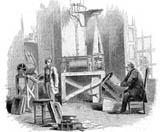Chronograph


The Troughton telescope had used an object glass of 5 inches diameter, which, at the time of its manufacture, in 1793, was the largest ever made by the optician Peter Dollond. Airy's new telescope had an object glass of 8.1-inch diameter. It had a magnification of 195, and most importantly, incorporated a number of measures to reduce the overall errors incurred in observations. There are, for example six micrometers for reading the scale, which gives the angle above the horizon of the star. Each is read, and an average of the six is taken, so even if one is slightly out, the reading is still very accurate.
When making a transit observation, one major source of error was the reaction time of the observer between when he (and it was always a he) observed the star, and when he noted the time. To reduce this error Airy came up with a way of linking both. With this chronograph, instead of observing the star, listening to or glancing at the regulator, and then mentally registering the time before noting it down, all the observer had to do was observe the star and simultaneously tap a key.
The barrel chronograph, from Dunkin's The Midnight Sky
The task of reading the chronograph sheets to extract the time for each observation was then passed down the production line to the computers, as the clerks who did the calculations were called. The observers' role was therefore reduced to just making the observations, while interpretation of these observations was left to the computers. As it happens, there was a certain amount of cross over, with many of the observers having some of their time assigned to computing duty, while some computers spent a portion of their time being trained up as observers

0 Comments:
Post a Comment
<< Home